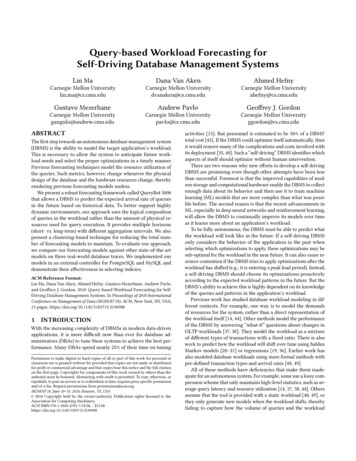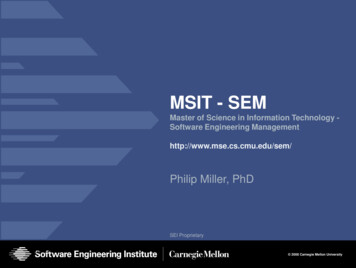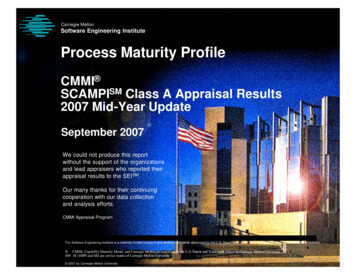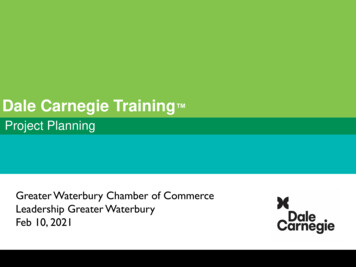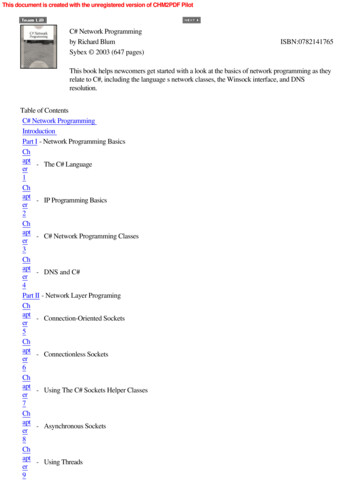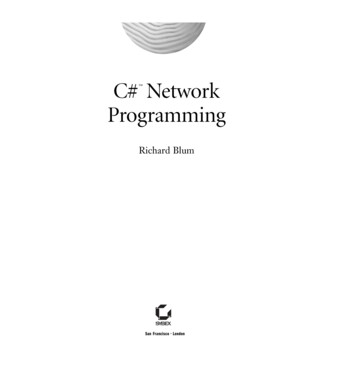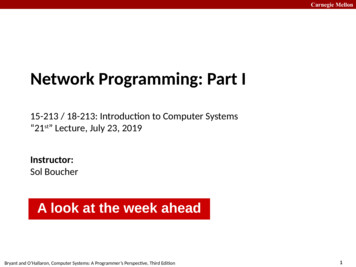
Transcription
Carnegie MellonNetwork Programming: Part I15-213 / 18-213: Introduction to Computer Systems“21st” Lecture, July 23, 2019Instructor:Sol BoucherA look at the week aheadBryant and O’Hallaron, Computer Systems: A Programmer’s Perspective, Third Edition1
Carnegie MellonA Client-Server Transaction Most network applications are based on the client-server model: A server process and one or more client processesServer manages some resourceServer provides service by manipulating resource for clientsServer activated by request from client (vending machine analogy)1. Client sends requestClientprocess4. ClienthandlesresponseServerprocess3. Server sends responseResource2. ServerhandlesrequestNote: clients and servers are processes running on hosts(can be the same or different hosts)Bryant and O’Hallaron, Computer Systems: A Programmer’s Perspective, Third Edition2
Carnegie MellonHardware Organization of a Network HostCPU chipregister fileALUsystem busmemory busmainmemoryI/ObridgeMIExpansion slotsI/O busUSBcontrollermouse rdisknetworkmonitorBryant and O’Hallaron, Computer Systems: A Programmer’s Perspective, Third Edition3
Carnegie MellonComputer Networks A network is a hierarchical system of boxes and wiresorganized by geographical proximity LAN (Local Area Network) spans a building or campusEthernet is most prominent example WAN (Wide Area Network) spans country or world Typically high-speed point-to-point fiber-optic links An internetwork (internet) is an interconnected set ofnetworks The Global IP Internet (uppercase “I”) is the most famous exampleof an internet (lowercase “i”) Let’s see how an internet is built from the ground upBryant and O’Hallaron, Computer Systems: A Programmer’s Perspective, Third Edition4
Carnegie MellonToday Network hardwareNetwork protocols and software1) Addresses2) Names 3) ConnectionsThe WebBryant and O’Hallaron, Computer Systems: A Programmer’s Perspective, Third Edition5
Carnegie MellonLowest Level: Ethernet Segmenthosthost100 Mb/shost100 Mb/shubport Ethernet segment consists of a collection of hosts connectedby wires (twisted pairs) to a hub Spans room or floor in a building Operation Each Ethernet adapter has a unique 48-bit address (MAC address)E.g., 00:16:ea:e3:54:e6 Hosts send bits to any other host in chunks called frames Hub slavishly copies each bit from each port to every other port Every host sees every bit[Note: Hubs are obsolete. Bridges (switches, routers) became cheap enough to replace them]Bryant and O’Hallaron, Computer Systems: A Programmer’s Perspective, Third Edition6
Carnegie MellonNext Level: Bridged Ethernet SegmentAhosthosthubBhosthostX100 Mb/s switch100 Mb/s hub1 Gb/shub100 Mb/sswitchhost100 Mb/shosthosthubYhosthosthosthosthostC Spans building or campus Bridges cleverly learn which hosts are reachable from whichports and then selectively copy frames from port to portBryant and O’Hallaron, Computer Systems: A Programmer’s Perspective, Third Edition7
Carnegie MellonConceptual View of LANs For simplicity, hubs, bridges, and wires are often shown as acollection of hosts attached to a single wire:hosthost . hostBryant and O’Hallaron, Computer Systems: A Programmer’s Perspective, Third Edition8
Carnegie MellonNext Level: internets Multiple incompatible LANs can be physically connected byspecialized computers called routersThe connected networks are called an internet (lower case)hosthost .hosthosthost .LAN 1hostLAN 2routerWANrouterWANrouterLAN 1 and LAN 2 might be completely different, totally incompatible(e.g., Ethernet, Fibre Channel, 802.11*, T1-links, DSL, )Bryant and O’Hallaron, Computer Systems: A Programmer’s Perspective, Third Edition9
Carnegie MellonLogical Structure of an er Ad hoc interconnection of networks No particular topology Vastly different router & link capacities Activity: model 1Send packets from source to destination by hopping throughnetworks Router forms bridge from one network to another Different packets may take different routesBryant and O’Hallaron, Computer Systems: A Programmer’s Perspective, Third Edition10
Carnegie MellonToday Network hardwareNetwork protocols and software1) Addresses2) Names 3) ConnectionsThe WebBryant and O’Hallaron, Computer Systems: A Programmer’s Perspective, Third Edition11
Carnegie MellonThe Notion of an internet Protocol How is it possible to send bits across incompatible LANsand WANs? Solution: protocol software running on each host androuter Protocol is a set of rules that governs how hosts and routers shouldcooperate when they transfer data from network to network. Smooths out the differences between the different networksBryant and O’Hallaron, Computer Systems: A Programmer’s Perspective, Third Edition12
Carnegie MellonWhat Does an internet Protocol Do? Provides a naming scheme An internet protocol defines a uniform format for host addresses Each host (and router) is assigned at least one of these internetaddresses that uniquely identifies it Provides a delivery mechanism An internet protocol defines a standard transfer unit (packet) Packet consists of header and payload Header: contains info such as packet size, source and destinationaddressesPayload: contains data bits sent from source hostBryant and O’Hallaron, Computer Systems: A Programmer’s Perspective, Third Edition13
Carnegie MellonTransferring internet Data Via colsoftwareFH1LAN1 frame(3)Host Bdatainternet packet(2)Host pterLAN2 frame(4)PH: internet packet headerFH: LAN frame headerdataPHFH1dataPHFH2(5)protocolsoftwareBryant and O’Hallaron, Computer Systems: A Programmer’s Perspective, Third Edition14
Carnegie MellonTransferring internet Data Via EncapsulationLAN1Host ACaution:Headeraddressfields arestored asBIG Endian!client(1)dataprotocolsoftwareinternet packet(2)dataPHFH1LAN1 RouterFH1LAN2Host BLAN2adapterLAN2 frame(4)PH: internet packet headerFH: LAN frame headerdataPHFH1dataPHFH2(5)protocolsoftwareBryant and O’Hallaron, Computer Systems: A Programmer’s Perspective, Third Edition15
Carnegie MellonHardware and Software Organizationof an Internet ApplicationInternet client hostInternet server hostClientUser codeServerTCP/IPKernel codeTCP/IPSockets interface(system calls)Hardware interface(interrupts)NetworkadapterHardwareand firmwareNetworkadapterGlobal IP InternetBryant and O’Hallaron, Computer Systems: A Programmer’s Perspective, Third Edition16
Carnegie MellonOther Issues We are glossing over a number of important questions: What if different networks have different maximum frame sizes?(segmentation) How do routers know where to forward frames? How are routers informed when the network topology changes? What if packets get lost? These (and other) questions are addressed by the area ofsystems known as computer networkingBryant and O’Hallaron, Computer Systems: A Programmer’s Perspective, Third Edition17
Carnegie MellonA Programmer’s View of the Internet1. Hosts are mapped to a set of 32-bit IP addresses 128.2.203.1792. The set of IP addresses is mapped to a set of identifierscalled Internet domain names 128.2.217.3 is mapped to www.cs.cmu.edu3. A process on one Internet host can communicate with aprocess on another Internet host over a connectionBryant and O’Hallaron, Computer Systems: A Programmer’s Perspective, Third Edition18
Carnegie MellonToday Network hardwareNetwork protocols and software1) Addresses2) Names 3) ConnectionsThe WebBryant and O’Hallaron, Computer Systems: A Programmer’s Perspective, Third Edition19
Carnegie Mellon(1) IP Addresses 32-bit IP addresses are stored in an IP address struct IP addresses are always stored in memory in network byte order(big-endian byte order) True in general for any integer transferred in a packet header from onemachine to another. E.g., the port number used to identify an Internet connection./* Internet address structure */struct in addr {uint32 t s addr; /* network byte order (big-endian) */};Bryant and O’Hallaron, Computer Systems: A Programmer’s Perspective, Third Edition20
Carnegie MellonDotted Decimal Notation By convention, each byte in a 32-bit IP address is representedby its decimal value and separated by a period IP address: 0x8002C2F2 128.2.194.242Use getaddrinfo and getnameinfo functions (describedlater) to convert between IP addresses and dotted decimalformat.Bryant and O’Hallaron, Computer Systems: A Programmer’s Perspective, Third Edition21
Carnegie MellonAside: IPv4 and IPv6 The original Internet Protocol, with its 32-bit addresses, isknown as Internet Protocol Version 4 (IPv4)1996: Internet Engineering Task Force (IETF) introducedInternet Protocol Version 6 (IPv6) with 128-bit addresses Intended as the successor to IPv4 Majority of Internet traffic still carried by IPv4IPv6 traffic at Google We will focus on IPv4, but will show you how to writenetworking code that is protocol-independent.Bryant and O’Hallaron, Computer Systems: A Programmer’s Perspective, Third Edition22
Carnegie MellonToday Network hardwareNetwork protocols and software1) Addresses2) Names 3) ConnectionsThe WebBryant and O’Hallaron, Computer Systems: A Programmer’s Perspective, Third Edition23
Carnegie Mellon(2) Internet Domain Namesunnamed rst-level domain namesSecond-level domain namesThird-level domain 28.2.131.66Bryant and O’Hallaron, Computer Systems: A Programmer’s Perspective, Third Edition24
Carnegie MellonDomain Naming System (DNS) The Internet maintains a mapping between IP addresses anddomain names in a huge worldwide distributed database calledDNSConceptually, programmers can view the DNS database as acollection of millions of host entries. Each host entry defines the mapping between a set of domain names and IPaddresses. In a mathematical sense, a host entry is an equivalence class of domainnames and IP addresses.Activity: models 2 and 3Bryant and O’Hallaron, Computer Systems: A Programmer’s Perspective, Third Edition25
Carnegie MellonProperties of DNS Mappings Can explore properties of DNS mappings using nslookup (Output edited for brevity) Each host has a locally defined domain name localhostwhich always maps to the loopback address 127.0.0.1linux nslookup localhostAddress: 127.0.0.1 Use hostname to determine real domain name of local host:linux hostnamewhaleshark.ics.cs.cmu.eduBryant and O’Hallaron, Computer Systems: A Programmer’s Perspective, Third Edition26
Carnegie MellonProperties of DNS Mappings (cont) Simple case: one-to-one mapping between domain name and IPaddress:linux nslookup whaleshark.ics.cs.cmu.eduAddress: 128.2.210.175 Multiple domain names mapped to the same IP address:linux nslookup cs.mit.eduAddress: 18.62.1.6linux nslookup eecs.mit.eduAddress: 18.62.1.6Bryant and O’Hallaron, Computer Systems: A Programmer’s Perspective, Third Edition27
Carnegie MellonProperties of DNS Mappings (cont) Multiple domain names mapped to multiple IP addresses:linux nslookup www.twitter.comAddress: 104.244.42.65Address: 104.244.42.129Address: 104.244.42.193Address: 104.244.42.1linux nslookup www.twitter.comAddress: 104.244.42.129Address: 104.244.42.65Address: 104.244.42.193Address: 104.244.42.1 Some valid domain names don’t map to any IP address:linux nslookup ics.cs.cmu.edu(No Address given)Bryant and O’Hallaron, Computer Systems: A Programmer’s Perspective, Third Edition28
Carnegie MellonToday Network hardwareNetwork protocols and software1) Addresses2) Names 3) ConnectionsThe WebBryant and O’Hallaron, Computer Systems: A Programmer’s Perspective, Third Edition29
Carnegie Mellon(3) Internet Connections Clients and servers communicate by sending streams of bytesover connections. Each connection is: Point-to-point: connects a pair of processes. Full-duplex: data can flow in both directions at the same time, A socket is an endpoint of a connection Socket address is an IPaddress:port pair A port is a 16-bit integer that identifies a process: Ephemeral port: Assigned automatically by client kernel when clientmakes a connection request. Well-known port: Associated with some service provided by a server(e.g., port 80 is associated with Web servers)Bryant and O’Hallaron, Computer Systems: A Programmer’s Perspective, Third Edition30
Carnegie MellonAnatomy of a Connection A connection is uniquely identified by the socketaddresses of its endpoints (socket pair) (cliaddr:cliport, servaddr:servport)Client socket address128.2.194.242:51213ClientServer socket address208.216.181.15:80Connection socket pair(128.2.194.242:51213, 208.216.181.15:80)Client host address128.2.194.242Server(port 80)Server host address208.216.181.15Activity: models 4 and 551213 is an ephemeral portallocated by the kernelBryant and O’Hallaron, Computer Systems: A Programmer’s Perspective, Third Edition80 is a well-known portassociated with Web servers31
Carnegie MellonUsing Ports to Identify ServicesServer host 128.2.194.242Client hostClientService request for128.2.194.242:80(i.e., the Web server)Web server(port 80)KernelEcho server(port 7)ClientService request for128.2.194.242:7(i.e., the echo server)Web server(port 80)KernelEcho server(port 7)Bryant and O’Hallaron, Computer Systems: A Programmer’s Perspective, Third Edition32
Carnegie MellonWell-known Service Names and Ports Popular services have permanently assigned well-knownports and corresponding well-known service names: echo servers:ftp servers:ssh servers:email servers:Web servers:echo 7ftp 21ssh 22smtp 25http 80Map between well-known ports and service names iscontained in the file /etc/services on each Linuxmachine.Bryant and O’Hallaron, Computer Systems: A Programmer’s Perspective, Third Edition33
Carnegie MellonGlobal IP Internet (upper case) Most famous example of an internetBased on the TCP/IP protocol family IP (Internet Protocol)Provides basic naming scheme and unreliable delivery capabilityof packets (datagrams) from host-to-host UDP (Unreliable Datagram Protocol) Uses IP to provide unreliable datagram delivery fromprocess-to-process TCP (Transmission Control Protocol) Uses IP to provide reliable byte streams from process-to-processover connections TCP extends connection properties at the cost of overhead: Reliability: Stream of bytes sent by the source is eventually received bythe destination. Ordering: .and appear to arrive in the same order they were sent.Bryant and O’Hallaron, Computer Systems: A Programmer’s Perspective, Third Edition34
Carnegie MellonToday Network hardwareNetwork protocols and software1) Addresses2) Names 3) ConnectionsThe WebBryant and O’Hallaron, Computer Systems: A Programmer’s Perspective, Third Edition35
Carnegie MellonWeb Server Basics Clients and servers communicateusing the HyperText TransferProtocol (HTTP) Client and server establish TCPconnection Client requests content Server responds with requestedcontent Client and server close connection(eventually) Current version is HTTP/1.1 RFC 2616, June, 1999.HTTP requestWebclient(browser)WebserverHTTP response(content)HTTPTCPIPWeb /rfc2616/rfc2616.htmlBryant and O’Hallaron, Computer Systems: A Programmer’s Perspective, Third Edition36
Carnegie MellonWeb Content Web servers return content to clients content: a sequence of bytes with an associated MIME (MultipurposeInternet Mail Extensions) type Example MIME types text/html text/plain image/gifformat image/pngformat image/jpegformatHTML documentUnformatted textBinary image encoded in GIFBinar image encoded in PNGBinary image encoded in JPEGYou can find the complete list of MIME types ia-types.xhtmlBryant and O’Hallaron, Computer Systems: A Programmer’s Perspective, Third Edition37
Carnegie MellonStatic and Dynamic Content The content returned in HTTP responses can be eitherstatic or dynamic Static content: content stored in files and retrieved in response toan HTTP request Examples: HTML files, images, audio clips, Javascript programs Request identifies which content file Dynamic content: content produced on-the-fly in response to anHTTP request Example: content produced by a program executed by theserver on behalf of the client Request identifies file containing executable code Bottom line: Web content is associated with a file that ismanaged by the serverBryant and O’Hallaron, Computer Systems: A Programmer’s Perspective, Third Edition38
Carnegie MellonURLs and how clients and servers use them Unique name for a file: URL (Universal Resource Locator)Example URL: http://www.cmu.edu:80/index.htmlClients use prefix (http://www.cmu.edu:80) to infer: What kind (protocol) of server to contact (HTTP) Where the server is (www.cmu.edu)Activity: What port it is listening on (80) model 6Servers use suffix (/index.html) to: Determine if request is for static or dynamic content. No hard and fast rules for this One convention: executables reside in cgi-bin directory Find file on file system Initial “/” in suffix denotes home directory for requested content. Minimal suffix is “/”, which server expands to configured defaultfilename (usually, index.html)Bryant and O’Hallaron, Computer Systems: A Programmer’s Perspective, Third Edition39
Carnegie MellonHTTP Requests HTTP request is a request line, followed by zero or morerequest headers Request line: method uri version method is one of GET, POST, OPTIONS, HEAD, PUT,DELETE, or TRACE uri is typically URL for proxies, URL suffix for servers A URL is a type of URI (Uniform Resource Identifier) See http://www.ietf.org/rfc/rfc2396.txt version is HTTP version of request (HTTP/1.0 or HTTP/1.1) Request headers: header name : header data Provide additional information to the serverBryant and O’Hallaron, Computer Systems: A Programmer’s Perspective, Third Edition40
Carnegie MellonHTTP Responses HTTP response is a response line followed by zero or moreresponse headers, possibly followed by content, with blank line(“\r\n”) separating headers from content. Response line: version status code status msg version is HTTP version of the response status code is numeric status status msg is corresponding English text 200301404OKRequest was handled without errorMovedProvide alternate URLNot foundServer couldn’t find the fileResponse headers: header name : header data Provide additional information about response Content-Type: MIME type of content in response body Content-Length: Length of content in response bodyBryant and O’Hallaron, Computer Systems: A Programmer’s Perspective, Third Edition41
Carnegie MellonTesting Servers Using telnet The telnet program is invaluable for testing serversthat transmit ASCII strings over Internet connections Our simple echo server Web servers Mail servers Usage: linux telnet host portnumber Creates a connection with a server running on host andlistening on port portnumber Bryant and O’Hallaron, Computer Systems: A Programmer’s Perspective, Third Edition42
Carnegie MellonAdditional slidesBryant and O’Hallaron, Computer Systems: A Programmer’s Perspective, Third Edition43
Carnegie MellonSockets Interface Set of system-level functions used in conjunction withUnix I/O to build network applications. Created in the early 80’s as part of the original Berkeleydistribution of Unix that contained an early version of theInternet protocols. Available on all modern systems Unix variants, Windows, OS X, IOS, Android, ARMBryant and O’Hallaron, Computer Systems: A Programmer’s Perspective, Third Edition44
Carnegie MellonSockets What is a socket? To the kernel, a socket is an endpoint of communication To an application, a socket is a file descriptor that lets theapplication read/write from/to the network Remember: All Unix I/O devices, including networks, aremodeled as files Clients and servers communicate with each other byreading from and writing to socket descriptorsClientclientfd ServerserverfdThe main distinction between regular file I/O and socketI/O is how the application “opens” the socket descriptorsBryant and O’Hallaron, Computer Systems: A Programmer’s Perspective, Third Edition45
Carnegie MellonSocket Address Structures Generic socket address: For address arguments to connect, bind, and accept Necessary only because C did not have generic (void *) pointers whenthe sockets interface was designed For casting convenience, we adopt the Stevens convention:typedef struct sockaddr SA;struct sockaddr {uint16 t sa family;charsa data[14];};/* Protocol family *//* Address data */sa familyFamily SpecificBryant and O’Hallaron, Computer Systems: A Programmer’s Perspective, Third Edition56
Carnegie MellonSocket Address Structures Internet (IPv4) specific socket address: Must cast (struct sockaddr in *) to (struct sockaddr *)for functions that take socket address arguments.struct sockaddr in {uint16 tsin family;uint16 tsin port;struct in addr sin addr;unsigned charsin zero[8];};sin port/*/*/*/*Protocol family (always AF INET) */Port num in network byte order */IP addr in network byte order */Pad to sizeof(struct sockaddr) */sin addr0AF INET0000000sa familysin familyFamily SpecificBryant and O’Hallaron, Computer Systems: A Programmer’s Perspective, Third Edition57
Carnegie MellonHost and Service Conversion: getaddrinfo getaddrinfo is the modern way to convert stringrepresentations of hostnames, host addresses, ports, andservice names to socket address structures. Replaces obsolete gethostbyname and getservbyname funcs. Advantages: Reentrant (can be safely used by threaded programs). Allows us to write portable protocol-independent code Works with both IPv4 and IPv6Disadvantages Somewhat complex Fortunately, a small number of usage patterns suffice in most cases.Bryant and O’Hallaron, Computer Systems: A Programmer’s Perspective, Third Edition58
Carnegie MellonHost and Service Conversion: getaddrinfoint getaddrinfo(const char *host,/*const char *service,/*const struct addrinfo *hints,/*struct addrinfo **result);/*Hostname or address */Port or service name */Input parameters */Output linked list */void freeaddrinfo(struct addrinfo *result);/* Free linked list */const char *gai strerror(int errcode);/* Return error msg */ Given host and service, getaddrinfo returns resultthat points to a linked list of addrinfo structs, each of whichpoints to a corresponding socket address struct, and whichcontains arguments for the sockets interface functions.Helper functions: freeadderinfo frees the entire linked list. gai strerror converts error code to an error message.Bryant and O’Hallaron, Computer Systems: A Programmer’s Perspective, Third Edition59
Carnegie MellonLinked List Returned by getaddrinforesultaddrinfo structsai canonnameai addrai nextSocket address structsNULLai addrai nextNULLai addrNULL Clients: walk this list, trying each socket address in turn, untilthe calls to socket and connect succeed.Servers: walk the list until calls to socket and bind succeed.Bryant and O’Hallaron, Computer Systems: A Programmer’s Perspective, Third Edition60
Carnegie Mellonaddrinfo Structstruct addrinfo {intai flags;/* Hints argument flags */intai family;/* First arg to socket function */intai socktype; /* Second arg to socket function */intai protocol; /* Third arg to socket function */char*ai canonname; /* Canonical host name */size tai addrlen;/* Size of ai addr struct */struct sockaddr *ai addr;/* Ptr to socket address structure */struct addrinfo *ai next;/* Ptr to next item in linked list */}; Each addrinfo struct returned by getaddrinfo containsarguments that can be passed directly to socket function.Also points to a socket address struct that can be passeddirectly to connect and bind functions.Bryant and O’Hallaron, Computer Systems: A Programmer’s Perspective, Third Edition61
Carnegie MellonHost and Service Conversion: getnameinfo getnameinfo is the inverse of getaddrinfo, converting asocket address to the corresponding host and service. Replaces obsolete gethostbyaddr and getservbyport funcs. Reentrant and protocol independent.int getnameinfo(const SA *sa, socklen t salen,char *host, size t hostlen,char *serv, size t servlen,int flags);Bryant and O’Hallaron, Computer Systems: A Programmer’s Perspective, Third Edition/*/*/*/*In: socket addr */Out: host */Out: service */optional flags */62
Carnegie MellonConversion Example#include "csapp.h"int main(int argc, char **argv){struct addrinfo *p, *listp, hints;char buf[MAXLINE];int rc, flags;/* Get a list of addrinfo records */memset(&hints, 0, sizeof(struct addrinfo));// hints.ai family AF INET;/* IPv4 only */hints.ai socktype SOCK STREAM; /* Connections only */if ((rc getaddrinfo(argv[1], NULL, &hints, &listp)) ! 0) {fprintf(stderr, "getaddrinfo error: %s\n", gai strerror(rc));exit(1);}hostinfo.cBryant and O’Hallaron, Computer Systems: A Programmer’s Perspective, Third Edition63
Carnegie MellonConversion Example (cont)/* Walk the list and display each IP address */flags NI NUMERICHOST; /* Display address instead of name */for (p listp; p; p p- ai next) {Getnameinfo(p- ai addr, p- ai addrlen,buf, MAXLINE, NULL, 0, flags);printf("%s\n", buf);}/* Clean up */Freeaddrinfo(listp);exit(0);}Bryant and O’Hallaron, Computer Systems: A Programmer’s Perspective, Third Editionhostinfo.c64
Carnegie MellonRunning hostinfowhaleshark ./hostinfo localhost127.0.0.1whaleshark ./hostinfo whaleshark.ics.cs.cmu.edu128.2.210.175whaleshark ./hostinfo 02199.16.156.198whaleshark ./hostinfo yant and O’Hallaron, Computer Systems: A Programmer’s Perspective, Third Edition65
Carnegie MellonBasic Internet Components Internet backbone: collection of routers (nationwide or worldwide) connected by high-speedpoint-to-point networks Internet Exchange Points (IXP): router that connects multiple backbones (often referred to as peers) Also called Network Access Points (NAP) Regional networks: smaller backbones that cover smaller geographical areas(e.g., cities or states) Point of presence (POP): machine that is connected to the Internet Internet Service Providers (ISPs): provide dial-up or direct access to POPsBryant and O’Hallaron, Computer Systems: A Programmer’s Perspective, Third Edition67
Carnegie MellonInternet Connection HierarchyPrivate“peering”agreementsbetweentwo backbonecompaniesoften ePOPColocationsitesBackbonePOPPOPPOPT3Regional netPOPPOPT1ISP (for individuals)ISPPOPPOPT1Small BusinessBryant and O’Hallaron, Computer Systems: A Programmer’s Perspective, Third EditionBig BusinessPOPPOPCablemodemPgh employeePOPDSLDC employee68
Carnegie MellonIP Address Structure IP (V4) Address space divided into classes:01238Class A 0 Net IDClass B 1 0Net IDClass C 1101624Host IDHost IDNet IDClass D 1 1 1 0Multicast addressClass EReserved for experiments111131Host IDNetwork ID Written in form w.x.y.z/n n number of bits in host address E.g., CMU written as 128.2.0.0/16 Class B addressUnrouted (private) IP addresses:10.0.0.0/8 172.16.0.0/12 192.168.0.0/16Bryant and O’Hallaron, Computer Systems: A Programmer’s Perspective, Third Edition69
Carnegie MellonEvolution of Internet Original Idea Every node on Internet would have unique IP address Everyone would be able to talk directly to everyone No secrecy or authentication Messages visible to routers and hosts on same LAN Possible to forge source field in packet header Shortcomings There aren't enough IP addresses available Don't want everyone to have access or knowledge of all other hosts Security issues mandate secrecy & authenticationBryant and O’Hallaron, Computer Systems: A Programmer’s Perspective, Third Edition70
Carnegie MellonEvolution of Internet: Naming Dynamic address assignment Most hosts don't need to have known address Only those functioning as servers DHCP (Dynamic Host Configuration Protocol) Local ISP assigns address for temporary use Example: Laptop at CMU (wired connection) IP address 128.2.213.29 (bryant-tp4.cs.cmu.edu) Assigned statically Laptop at home IP address 192.168.1.5 Only valid within home networkBryant and O’Hallaron, Computer Systems: A Programmer’s Perspective, Third Edition71
Carnegie MellonEvolution of Internet: Corporation XInternet Firewalls Hides organizations nodes from rest of Internet Use local IP addresses within organization For external service, provides proxy service1.2.3.4.Client request: src 10.2.2.2, dest 216.99.99.99Firewall forwards: src 176.3.3.3, dest 216.99.99.99Server responds: src 216.99.99.99, dest 176.3.3.3Firewall forwards response: src 216.99.99.99, dest 10.2.2.2Bryant and O’Hallaron, Computer Systems: A Programmer’s Perspective, Third Edition72
Carnegie Mellon Bryant and O'Hallaron, Computer Systems: A Programmer's Perspective, Third Edition 2 A Client-Server Transaction Most network applications are based on the client-server model: A server process and one or more client processes Server manages some resource Server provides service by manipulating resource for clients Server activated by request from client (vending machine .
